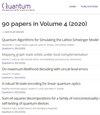Bounds on Autonomous Quantum Error Correction
IF 5.1
2区 物理与天体物理
Q1 PHYSICS, MULTIDISCIPLINARY
引用次数: 0
Abstract
Autonomous quantum memories are a way to passively protect quantum information using engineered dissipation that creates an “always-on'' decoder. We analyze Markovian autonomous decoders that can be implemented with a wide range of qubit and bosonic error-correcting codes, and derive several upper bounds and a lower bound on the logical error rate in terms of correction and noise rates. These bounds suggest that, in general, there is always a correction rate, possibly size-dependent, above which autonomous memories exhibit arbitrarily long coherence times. For any given autonomous memory, size dependence of this correction rate is difficult to rule out: we point to common scenarios where autonomous decoders that stochastically implement active error correction must operate at rates that grow with code size. For codes with a threshold, we show that it is possible to achieve faster-than-polynomial decay of the logical error rate with code size by using superlogarithmic scaling of the correction rate. We illustrate our results with several examples. One example is an exactly solvable global dissipative toric code model that can achieve an effective logical error rate that decreases exponentially with the linear lattice size, provided that the recovery rate grows proportionally with the linear lattice size.自主量子纠错的边界
自主量子存储器是一种被动保护量子信息的方法,它使用工程耗散来创建一个“永远在线”的解码器。我们分析了可以用广泛的量子比特和玻色子纠错码实现的马尔可夫自治解码器,并从纠错率和噪声率方面推导了逻辑错误率的上界和下界。这些界限表明,在一般情况下,总是有一个修正率,可能与大小有关,超过这个修正率,自主记忆表现出任意长的相干时间。对于任何给定的自主存储器,这种纠错率的大小依赖性很难排除:我们指出了随机实现主动纠错的自主解码器必须以随代码大小增长的速率运行的常见场景。对于具有阈值的代码,我们表明可以通过使用更正率的超对数缩放来实现逻辑错误率随代码大小的衰减速度超过多项式。我们用几个例子来说明我们的结果。一个例子是一个完全可解的全局耗散环码模型,它可以实现一个有效的逻辑错误率,该错误率随线性晶格大小呈指数下降,前提是回收率随线性晶格大小成比例地增长。
本文章由计算机程序翻译,如有差异,请以英文原文为准。
求助全文
约1分钟内获得全文
求助全文
来源期刊

Quantum
Physics and Astronomy-Physics and Astronomy (miscellaneous)
CiteScore
9.20
自引率
10.90%
发文量
241
审稿时长
16 weeks
期刊介绍:
Quantum is an open-access peer-reviewed journal for quantum science and related fields. Quantum is non-profit and community-run: an effort by researchers and for researchers to make science more open and publishing more transparent and efficient.
 求助内容:
求助内容: 应助结果提醒方式:
应助结果提醒方式:


